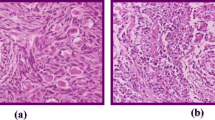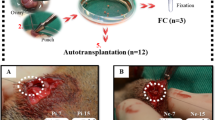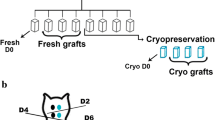Abstract
Purpose: The study aimed to determine effects of FSH applications on follicle survival, development and hormone output and antigenicity of rat ovarian tissue autografts placed at subcutaneous or subperitoneal sites.
Methods: A total of sixteen female rats were used in the study. The animals were divided into three groups. Ovaries were dissected and then transplanted under the peritoneum in the first group animals (n = 5) or under the skin in the second group animals (n = 6). And the animals in the third group (n = 5) were sham operated. Following operations, intramuscular injection of 8 IU of rhFSH were made daily to the animals in first and second groups from the first day of operation through thirty days. Vaginal irrigation samples were prepared daily from the animals for 30 days. The concentrations of serum estradiol and antiovarian antibodies in the blood were determined using ELISA on the last day of vaginal irrigations. Histopathological examination of the ovaries that were transplanted was made.
Results: Results showed that cyclic variations were noticed in the samples of vaginal irrigation by day 30 in the animals of first and second groups. However, no significant differences were seen between groups. The concentration of blood serum estradiol was higher in the animals of first group. Decrease in numbers of primary follicles were found in the animals of second group and lesser corpus luteum were found in the animals of control group on the histopathological examinations of transplanted ovaries. All rats in the first and second groups were defined as seropositive for antiovarian antibodies. When the OD values were compared between first and second groups, it was identified that the OD values of rats in the first group was higher than it was seen in the second group.
Conclusion: The ovarian transplantation without vascular pedicle in rats is characterized by follicular hyperplasia endocrinologically functional. Being seropositive of all rats in first and second groups in terms of antiovarian antibodies is an indicator to these antibodies does not affect the functions of transplanted ovaries. It is believed that the highness of OD values in the group which is transplanted beneath the peritoneum is based on the highness of estradiol concentrations in these animals.



Similar content being viewed by others
References
Paris MCJ, Snow M, Cox SL, Jill MS. Xenotransplantation: a tool for reproductive biology and animal conservation? Theriogenology 2004;61:277–91.
Arnold S, Hubler M, Casal M, Lott SG, Hauser B, Rusch P. The transplantation of autologous ovarian tissue in the bitch for the prevention of side effects due to spaying. A retrospective study several years after surgery. E J Comp Anim Pract 1992;3:67–71.
Cox SL, Shaw JM, Jenkin G. Transplantation of cryopreserved foetal ovarian tissue to adult recipients in mice. J Reprod Fertil 1996;107:315–22.
Gunasena KT, Villines PM, Critser ES, Critser JK. Live births after autologous transplant of cryopreserved mouse ovaries. Hum Reprod 1997;12:101–6.
Candy CJ, Wood MJ, Whittingham DG: Restoration of a normal reproductive lifespan after grafting of cryopreserved mouse ovaries. Hum Reprod 2000;15:1300–4.
Salle B, Lornage J, Franck M, Isoard L, Rudigoz RC, Guerin JF. Freezing, thawing, and autograft of ovarian fragments in sheep: preliminary experiments and histologic assessment. Fertil Steril 1998;70:124–8.
Imthurn B, Cox SL, Jenkin G, Trounson AO, Shaw JM. Gonadotrophin administration can benefit ovarian tissue grafted to the body wall: implications for ovarian grafting. Mol Cell Endocrin 2000;163:141–6.
Oktay K, Karlikaya G. Ovarian function after transplantation of frozen, banked autologous ovarian tissue. N Engl J Med 2000;342:1919.
Oktay K, Economos K, Kan M, Rucinski J, Veeck L, Rosenwaks Z. Endocrine function and oocyte retrieval after autologous transplantation of ovarian cortical strips to the forearm. J A M A 2001;286:1490–3.
Radford JA, Lieberman BA, Brison DR, Smith AR. Critchlow JD, Russell SA. Orthotopic reimplantation of cryopreserved ovarian cortical strips after high-dose chemotherapy for hodgkin’s lymphoma. Lancet 2001;357:1172–5.
Sztein J, Sweet H, Farley J, Mobraaten L. Cryopreservation and orthotopic transplantation of mouse ovaries: new approach in gamete banking. Biol Reprod 1998;58:71–4.
Yamamoto S, Konishi I, Tsuruta Y, Nanbu K, Mandai M, Kuroda H. Expression of vascular endothelial growth factor (VEGF) during folliculogenesis and corpus luteum formation in the human ovary. Gynecol Endocrinol 1997;11:371–81.
Dissen GA, Lara HE, Fahrenbach WH, Costa ME, Ojeda SR. Immature rat ovaries become revascularized rapidly after autotransplantation and show a gonadotropin-dependent increase in angiogenic factor gene expression. Endocrinology 1994;134:1146–54.
Luborsky J, Llanes B, Roussev R, Coulam C. Ovarian antibodies, fsh and inhibin b: independent markers associated with unexplained infertility. Hum Reprod 2000;15:1046–51.
Esfandiari N, Falcone T, Bedaiwy MA, Agarwal A, Jeremias E, Sharma RK. Autologous transplantation of cryopreserved ovary induces the generation of antiovary antibodies in sheep. Fertil Steril 2003;80:1062–4.
Narayanan M, Murthy PS, Munaf SA, Shah LC. Antiovarian antibodies and their effect on the outcome of assisted reproduction. J Assist Reprod Genet 1995;12:599–605.
Montes GS, Luque EH. Effects of ovarian steroids on vaginal smear in the Rat. Acta Anat 1988;133:192–9.
Risvanli A, Aydin M, Kaygusuzoglu E, Timurkan H. The effect of thyroidectomy on sexual cycle and pregnancy rates in rats. Turk J Vet Anim Sci 2003;27:873–7.
Pedersen T, Peters H. Proposal for a classification of oocytes and follicles in the mouse ovary. J Reprod Fertil 1968;17:555–7.
Risvanli A, Aydin M, Kaygusuzoglu E, Bulut H, Apaydin AM, Timurkan H. Use of cauda epididymis extract as immunocontraceptive. Contraception 2002;66:459–2.
Snedecor GW, Cochran WG. Statistical method. 7th ed. Ames, Iowa: The Iowa State University Pres, 1980.
SPSS, Release 9.0. Standard Version. Copyright SPSS Inc., 1999.
Salle B, Demirci B, Franck M, Rudigoz RC, Guerin JF, Lornage J. Normal pregnancies and live births after autograft of frozen-thawed hemi-ovaries into ewes. Fertil Steril 2002;77:403–8.
Callejo J, Jauregui MT, Vals C, Fernandez ME, Cabre S, Lailla JM. Heterotopic ovarian transplantation without vascular pedicle in syngeneic lewis rats: six-month control of estradiol and follicle-stimulating hormone concentrations after intraperitoneal and subcutaneous implants. Fertil Steril 1999;72:513–7.
Callejo J, Vilaseca S, Ordi J, Cabre S, Lailla JM, Balasch J. Heterotopic ovarian transplantation without vascular pedicle in syngeneic lewis rats: long-term evaluation of effects on ovarian structure and function. Fertil Steril 2002;77:396–402.
Chihal HJ, Stone SC, Peppler RD. The effect of frozen ovarian autografts on compensatory ovulation and steroid production in unilaterally ovariectomized rats. Am J Anat 1976;145:433–1.
Chihal HJ, Weitsen HA, Stone SC, Peppler RD. Autonomic innervation and plasma estradiol-17beta and progesterone levels in rats with subcutaneous ovarian autografts. Cell Tissue Res 1976;175:113–1.
Luborsky J. Ovarian autoimmune disease and ovarian autoantibodies. J Womens Health Gend Based Med 2002;11:585–9.
Author information
Authors and Affiliations
Corresponding author
Additional information
Supported by The Scientific and Technical Research Council of Turkey (105 O 008).
Rights and permissions
About this article
Cite this article
Risvanli, A., Timurkan, H., Akpolat, N. et al. A study of ovarian autotransplantation without vascular a pedicle in rats. J Assist Reprod Genet 23, 401–406 (2006). https://doi.org/10.1007/s10815-006-9078-5
Received:
Accepted:
Published:
Issue Date:
DOI: https://doi.org/10.1007/s10815-006-9078-5




